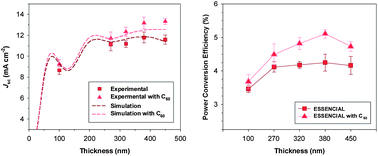Optimization of polymer photovoltaic cells with bulk heterojunction layers hundreds of nanometers thick: modifying the morphology and cathode interface†
Abstract
In

* Corresponding authors
a
Macromolecular Science & Engineering, The University of Michigan, Ann Arbor, MI, USA
E-mail:
guo@umich.edu
Fax: +1-734-763-9324
Tel: +1-734-647-7718
b Electrical Engineering & Computer Science, The University of Michigan, Ann Arbor, MI, USA
c Mechanical Engineering, The University of Michigan, Ann Arbor, MI, USA
In

 Please wait while we load your content...
Something went wrong. Try again?
Please wait while we load your content...
Something went wrong. Try again?
H. J. Park, H. Kim, J. Y. Lee, T. Lee and L. J. Guo, Energy Environ. Sci., 2013, 6, 2203 DOI: 10.1039/C3EE24410E
To request permission to reproduce material from this article, please go to the Copyright Clearance Center request page.
If you are an author contributing to an RSC publication, you do not need to request permission provided correct acknowledgement is given.
If you are the author of this article, you do not need to request permission to reproduce figures and diagrams provided correct acknowledgement is given. If you want to reproduce the whole article in a third-party publication (excluding your thesis/dissertation for which permission is not required) please go to the Copyright Clearance Center request page.
Read more about how to correctly acknowledge RSC content.
 Fetching data from CrossRef.
Fetching data from CrossRef.
This may take some time to load.
Loading related content
